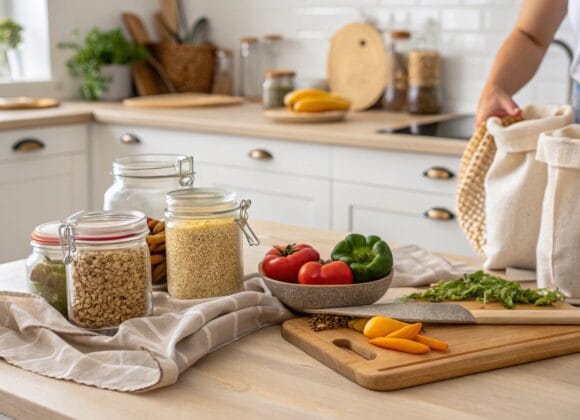Laundry day doesn’t have to mean compromising your environmental values. Creating an eco friendly laundry routine is one of the most impactful changes you can make in your household sustainability journey. Not only will you reduce your carbon footprint, but you’ll also save money, protect your family’s health, and contribute to cleaner waterways.
The average household does nearly 300 loads of laundry per year, using thousands of gallons of water and countless chemical-laden products. However, with a few simple swaps and mindful practices, you can transform this necessary chore into an environmentally conscious ritual that aligns with your green lifestyle.
Table of Contents
Choose Natural and Non-Toxic Laundry Products
The foundation of any eco friendly laundry routine starts with what you put in your washing machine. Conventional laundry detergents contain phosphates, optical brighteners, and synthetic fragrances that harm aquatic ecosystems and can irritate sensitive skin.
Making the switch to plant-based detergents is easier than ever. Look for products certified by organizations like EPA Safer Choice or ECOCERT. Brands like Seventh Generation, Ecover, and Molly’s Suds offer concentrated formulas that clean effectively while minimizing packaging waste.
For those who love DIY solutions, creating your own laundry detergent is surprisingly simple. Mix one cup of washing soda, one cup of borax, and one grated bar of castile soap. This mixture costs pennies per load and eliminates plastic packaging entirely. Store it in a glass jar for a completely plastic-free approach that complements your plastic free morning routine.
Don’t forget about fabric softeners and dryer sheets, which often contain harmful chemicals. White vinegar works as an excellent natural fabric softener, while wool dryer balls reduce drying time and eliminate static without any synthetic additives.
Master Water-Saving Washing Techniques
Water conservation plays a crucial role in sustainable laundry practices. The average washing machine uses 25-40 gallons per load, but strategic choices can dramatically reduce this consumption.
Always wash full loads when possible, as this maximizes water efficiency. However, if you must wash smaller loads, adjust your water level accordingly. Most modern machines have load-sensing technology, but older models may require manual adjustment.
Cold water washing is perhaps the most impactful change you can make. Heating water accounts for about 90% of your washing machine’s energy consumption. Modern detergents work effectively in cold water, and many fabrics actually last longer when washed in cooler temperatures. Reserve hot water for sanitizing items like towels, bedding, or clothing worn during illness.
Consider investing in a high-efficiency washing machine if your current model is over 10 years old. ENERGY STAR certified machines use 25% less energy and 33% less water than standard models, making them excellent long-term investments for your eco friendly laundry routine.
Pre-treating stains with natural solutions like lemon juice, baking soda, or hydrogen peroxide can eliminate the need for rewashing items, saving both water and energy.
Embrace Energy-Efficient Drying Methods
The clothes dryer is often the most energy-intensive appliance in your home, but there are numerous ways to reduce its environmental impact while maintaining convenience.
Line drying remains the most sustainable option. Whether you use an outdoor clothesline, indoor drying rack, or retractable line, air-drying eliminates energy consumption entirely. Your clothes will smell fresher, last longer, and you’ll reduce your electricity bill significantly.
For those who rely on machine drying, timing matters. Clean your lint filter before every load to improve airflow and efficiency. Additionally, try to dry consecutive loads while your dryer is still warm, taking advantage of residual heat.
Wool dryer balls deserve special mention in any eco friendly laundry routine. These reusable alternatives to dryer sheets reduce drying time by up to 25%, soften fabrics naturally, and last for years. Add a few drops of essential oils to them for a natural fragrance boost.
Consider partially air-drying heavy items like jeans or towels, then finishing them in the dryer for just 10-15 minutes. This hybrid approach saves energy while ensuring everything feels completely dry and soft.
Implement Smart Sorting and Frequency Strategies
Not every item in your hamper needs immediate washing. Developing a mindful approach to laundry frequency can significantly reduce your environmental impact while extending the life of your clothing.
Jeans, sweaters, and outer layers can often be worn multiple times before requiring a wash. Focus on washing undergarments, socks, and heavily soiled items after each use, while giving other garments the “sniff test” to determine if they truly need cleaning.
When sorting laundry, consider fabric weight and drying time rather than just colors. Washing lightweight items together allows for shorter wash cycles and faster drying, while heavy items like towels and blankets benefit from longer, more intensive cycles.
Invest in a few extra sets of bed linens so you can rotate them less frequently. This approach, similar to strategies discussed in zero waste cleaning tips, reduces the urgency around constant washing while ensuring you always have fresh bedding available.
Create designated hampers for different types of clothing to streamline your sorting process. This organization makes it easier to wash full loads efficiently and prevents overdoing laundry out of convenience.
Select Sustainable Laundry Tools and Accessories
The tools you use for laundry can either support or undermine your sustainability goals. Making thoughtful choices about these items enhances your overall eco friendly laundry routine.
Bamboo laundry baskets offer a renewable alternative to plastic options, while also being naturally antimicrobial and incredibly durable. Similarly, wooden clothespins last decades longer than plastic versions and biodegrade at the end of their life cycle.
Mesh laundry bags protect delicate items while reducing microplastic pollution from synthetic fabrics. These bags capture tiny fibers that would otherwise enter waterways, making them essential for anyone washing athletic wear or synthetic blends.
A good quality measuring cup ensures you use the correct amount of detergent every time. Using too much detergent doesn’t improve cleaning but does increase environmental impact and can actually trap dirt in fabric fibers.
Consider upgrading to a high-efficiency washing machine if yours is approaching replacement time. While the upfront investment is significant, these machines pay for themselves through reduced utility bills and align perfectly with sustainable living principles.
Address Stains Naturally and Effectively
Effective stain removal using natural ingredients prevents the need for rewashing items and eliminates harsh chemical treatments from your eco friendly laundry routine.
Create a stain-fighting arsenal with common household items. Baking soda works excellently on grease stains, while white vinegar tackles deodorant marks and mineral deposits. Lemon juice naturally bleaches and brightens whites, and hydrogen peroxide removes blood and protein-based stains.
For tough stains, make a paste with baking soda and water, let it sit for 30 minutes, then wash as usual. This method handles everything from grass stains to food spills without relying on commercial stain removers filled with synthetic chemicals.
Keep a spray bottle filled with equal parts water and white vinegar for immediate stain treatment. Addressing stains quickly prevents them from setting, making removal easier and reducing the likelihood of needing harsh treatments later.
Remember that some natural stain removal methods work better on specific fabrics. Always test solutions on an inconspicuous area first, especially on delicate or colored fabrics that might react unpredictably.
Maintain Your Washing Machine Sustainably
Regular maintenance keeps your washing machine running efficiently, extending its lifespan and maintaining optimal performance throughout your eco friendly laundry routine.
Clean your washing machine monthly using white vinegar and baking soda instead of commercial cleaners. Run an empty hot water cycle with two cups of vinegar, followed by a cycle with half a cup of baking soda. This removes soap residue, mineral deposits, and prevents odors naturally.
Check and clean your washing machine’s lint filter regularly if it has one. Many people don’t realize front-loading machines often have filters that require periodic cleaning for optimal performance.
Leave your washing machine door open after use to allow air circulation and prevent mold growth. This simple habit eliminates the need for antimicrobial treatments and keeps your machine fresh naturally.
Inspect hoses annually for signs of wear or mineral buildup. Replacing hoses proactively prevents water damage and ensures your machine operates efficiently, supporting both your sustainability goals and home maintenance routine.
Build Seasonal Laundry Habits
Adapting your eco friendly laundry routine to seasonal changes maximizes efficiency while responding to varying needs throughout the year.
Summer offers optimal conditions for line drying, so take full advantage of longer daylight hours and warm weather. This season also typically requires more frequent washing due to increased perspiration and outdoor activities.
Winter laundry focuses on energy conservation and indoor drying strategies. Invest in a good drying rack and position it near heat sources like radiators or sunny windows. The added humidity from drying clothes can actually benefit your home’s air quality during dry winter months.
Spring cleaning presents an opportunity to wash seasonal items like comforters, curtains, and winter gear before storing them. Use this time to deep clean your washing machine and reorganize your laundry area for maximum efficiency.
Fall preparation includes washing and properly storing summer clothing while bringing out heavier items that may need refreshing after months in storage. This seasonal rotation reduces overall laundry volume while ensuring everything is clean and ready when needed.
Extend Clothing Lifespan Through Proper Care
The most sustainable laundry approach involves washing clothes less frequently while maintaining their appearance and extending their useful life.
Learn to read care labels and follow them appropriately. Washing clothes in conditions that are too harsh shortens their lifespan significantly, leading to more frequent replacements and increased environmental impact.
Turn clothes inside out before washing to protect colors and reduce fabric pill formation. This simple step maintains appearance while reducing the need for fabric shavers or frequent replacements.
Use appropriate water temperatures for different fabric types. While cold water works for most items, some fabrics benefit from specific temperature ranges that balance cleanliness with fabric preservation.
Store seasonal clothing properly to prevent unnecessary washing when rotating your wardrobe. Clean items thoroughly before storage, use breathable containers, and add natural moth deterrents like cedar blocks or lavender sachets.
Conclusion: Start Your Sustainable Laundry Journey Today
Transforming your wash day routine into an eco friendly laundry routine doesn’t require perfection from day one. Start by implementing one or two changes, such as switching to cold water washing or trying wool dryer balls. As these habits become natural, gradually incorporate additional sustainable practices.
Remember that small changes compound over time. Washing one load per week in cold water instead of hot saves approximately 1,600 pounds of CO2 annually. Multiply that impact across millions of households, and the collective difference becomes substantial.
Your sustainable laundry journey connects to broader environmental consciousness, much like developing zero waste cleaning tips or establishing a plastic free morning routine. Each mindful choice contributes to a lifestyle that prioritizes both personal well-being and planetary health.
Take action today by choosing just one element from this guide to implement this week. Whether it’s making your own detergent, investing in wool dryer balls, or simply switching to cold water, every step moves you closer to a completely sustainable household routine. Your clothes, your wallet, and the environment will thank you for making the change.




